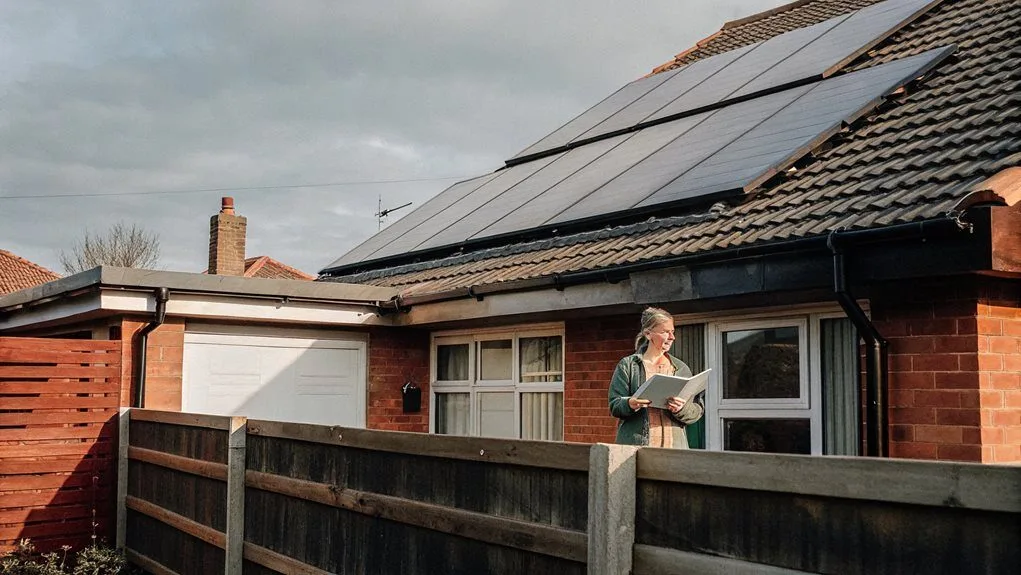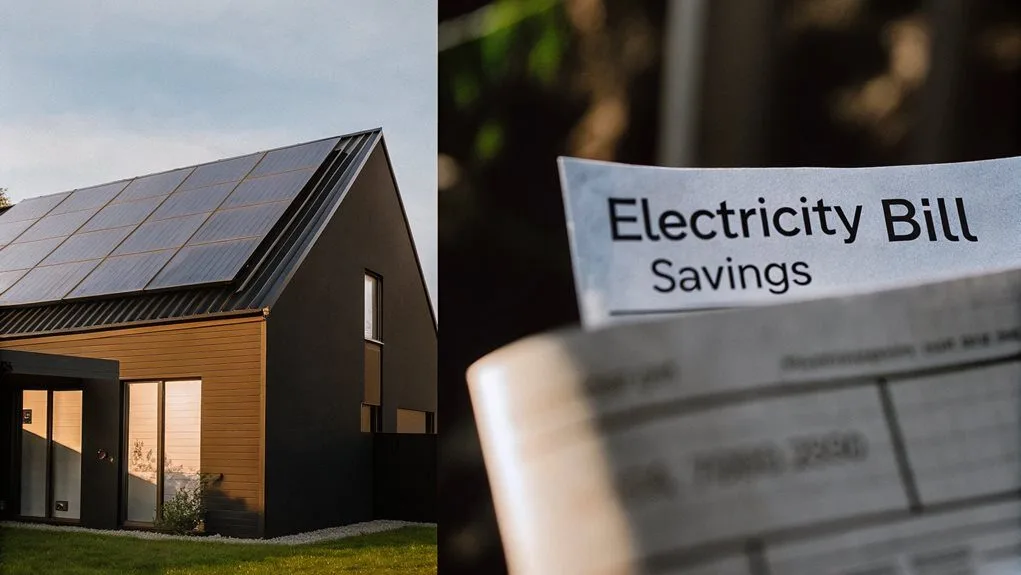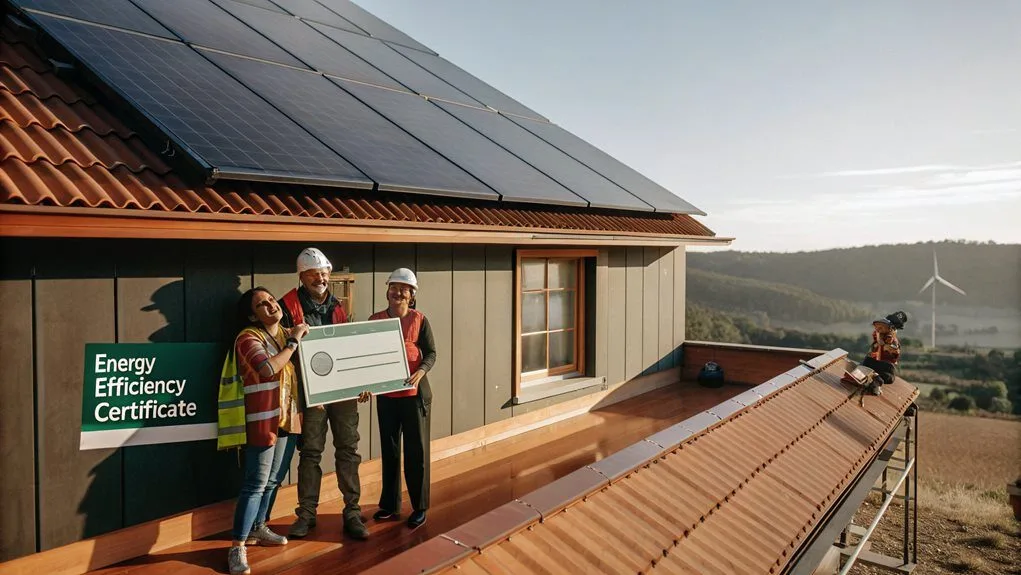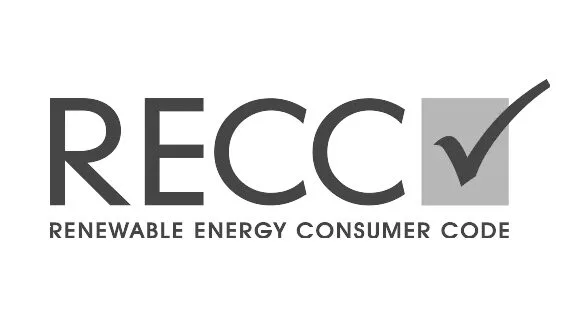Energy storage systems can greatly reduce monthly electric bills through storing excess energy during low-demand periods for use during peak hours. Homeowners with solar panels can maximise self-consumption, achieving up to 30% savings on energy costs.
The UK currently offers VAT relief on battery installations until 2027, making now an ideal time to invest. Battery systems typically pay for themselves within 7-10 years while providing energy independence and protection against future rate increases.
Discover how specific battery options align with your household’s unique energy profile.
How Energy Storage Slashes Your Monthly Electric Bills
While many homeowners struggle with rising electricity costs, energy storage systems offer a powerful solution for reducing monthly bills. These systems strategically store excess energy during low-demand periods for use when rates are highest, creating substantial energy savings over time.
Energy storage provides electric independence by reducing reliance on the grid during peak hours when utilities charge premium rates. By charging batteries with solar power during the day, homeowners can power their homes in the evening without purchasing expensive electricity.
The financial benefits extend beyond simple bill reduction:
- Maximises self-consumption of solar energy
- Utilises time-of-use pricing models
- Provides protection against future rate increases
- Reduces or eliminates costly demand charges
This optimisation creates a more efficient home energy ecosystem that consistently delivers long-term financial advantages. Installation costs have decreased significantly as battery technology advances, making energy storage systems increasingly accessible to average homeowners.
Peak Energy Cost Avoidance: Timing Your Power Usage Strategically
How can savvy homeowners dramatically reduce their electricity costs without sacrificing comfort? The answer lies in strategic management of consumption patterns during peak hours.
By understanding utility pricing models—particularly time-of-use and demand charges—homeowners can implement targeted energy strategies.
Load shifting represents one of the most effective approaches: simply scheduling tasks like laundry, dishwashing, and electric vehicle charging during off-peak periods can yield substantial cost savings. Battery Energy Storage Systems can help homeowners store energy during low-cost periods and use this stored energy during peak demand times.
More advanced techniques include:
- Participating in demand response programmes offered by utilities
- Installing efficiency upgrades to reduce overall consumption
- Using smart home systems to control energy use based on price signals
- Combining solar generation with battery storage to avoid drawing grid power during expensive periods
These strategies allow homeowners to maintain comfort while strategically minimising exposure to premium electricity rates.
Maximising Solar Panel Returns With Battery Storage Systems
Savvy homeowners access the full potential of their solar investments by pairing panels with battery storage systems. This combination markedly increases self-consumption of solar-generated electricity, reducing reliance on grid power.
Battery performance is critical to this arrangement, allowing excess daytime energy to be used during evening hours or cloudy periods. Systems like Tesla Powerwall and LG Chem RESU provide reliable storage options, though they require initial investments between £12,000-£22,000 beyond panel installation costs. Homeowners implementing these systems can achieve up to 30% savings on their energy bills through strategic use of stored power.
The benefits extend beyond financial returns:
- Improved energy independence during grid outages
- Silent, clean alternative to traditional generators
- Continued operation of critical home systems
- Reduced environmental impact through decreased fossil fuel reliance
While battery storage represents a higher upfront cost, federal tax credits and state incentives help offset this investment, making solar-plus-storage increasingly attractive.
UK Government Incentives and Rebates for Home Battery Installation
The UK government has recently expanded VAT relief to include standalone and retrofitted battery installations, offering significant savings for homeowners considering energy storage solutions.
This zero-percent VAT rate applies until March 31, 2027, making now an opportune time to invest in battery systems that complement solar panel installations.
From February 1, 2024, the policy became effective nationwide, expanding previous relief that was limited to batteries installed with solar panels.
Specific grants for battery storage remain limited, yet local authority schemes and collective purchasing programs like Solar Together provide other avenues for cost reduction in certain regions.
Current Incentive Schemes
Maneuvring through the UK government’s incentive structure reveals promising opportunities for homeowners considering battery installations.
The most significant development is the extension of VAT relief to standalone energy storage batteries and retrofitted installations, effective 1 February 2024. This creates substantial cost reductions compared to previous policies that limited relief to batteries installed alongside solar panels. Similar to the US federal tax credit, the UK’s approach aims to make clean energy solutions more affordable for the average homeowner.
While grant availability for home battery storage remains limited, funding opportunities typically target specific demographics:
- 0% VAT rate on battery systems until 31 March 2027
- Energy Company Obligation schemes focusing on lower-income households
- Regional programmes offering targeted support for energy efficiency improvements
The VAT relief represents the government’s commitment to making energy storage more affordable, potentially saving homeowners hundreds of pounds on installation costs while supporting the UK’s carbon reduction goals.
Regional Support Differences
Across the United Kingdom, three distinct patterns of support for home battery installations have emerged, creating a patchwork of opportunities for homeowners depending on their location. While VAT relief applies nationwide, regional disparities become apparent when examining local initiatives.
Schemes like Solar Together highlight these differences, offering collective purchasing programmes that can reduce costs by 10-25% in participating areas. These local initiatives vary considerably across regions, with some authorities providing additional support beyond national incentives. The current 0% VAT on battery storage installations until March 31, 2027 represents a significant nationwide savings opportunity for all homeowners regardless of regional location.
Despite the lack of battery-specific regional grants, homeowners should investigate area-specific energy efficiency programmes that might indirectly support storage solutions.
Most government schemes prioritise lower-income households or energy-inefficient properties, making eligibility criteria another important regional consideration.
ROI Timeline Projections
Beyond regional initiatives, financial considerations remain at the forefront for homeowners contemplating battery storage installations. With the UK government’s VAT relief reducing upfront costs until March 2027, ROI assessment has become increasingly favourable for battery projects.
The current 0% VAT rate (rising to 5% after 2027) considerably impacts investment strategies and shortens payback periods.
Analysing return timelines reveals:
- Short-term benefits: Immediate VAT relief reduces initial investment by approximately 20% compared to pre-2024 costs
- Medium-term gains: Energy bill reductions become more substantial between years 2-5 of ownership
- Long-term advantages: Complete system payback typically occurs within 7-10 years, depending on usage patterns
For maximum financial benefit, homeowners should strategically time installations to capitalise on current incentives while energy storage technology costs continue to decrease annually.
Real-Life Savings: Case Studies From UK Homeowners Using Energy Storage
While the concept of energy storage might seem abstract to many, real-world examples from UK homeowners demonstrate the tangible financial benefits these systems deliver.
The most persuasive evidence comes from a 1930s bungalow in Portobello, Edinburgh, where homeowner energy savings reached an impressive 76% reduction in electricity bills through strategic use of battery storage and off-peak tariffs. This change wasn’t merely incremental—it represented significant financial relief.
Other UK households report similar successes, with long-term savings exceeding £13,500 over a 15-year period.
Battery storage investments yield impressive returns, with UK households saving over £13,500 across 15 years.
These homeowner experiences validate what industry experts have projected: that battery storage, particularly when paired with smart technology and off-peak electricity rates, delivers substantial returns despite the initial investment.
Choosing the Right Battery System for Your Home’s Energy Profile
Selecting a battery system that aligns with your home’s unique energy profile requires careful consideration of several key factors.
Homeowners must evaluate the proper system size based on their daily energy consumption patterns, as an undersized system won’t meet needs while an oversized one wastes money.
Finding the right balance between upfront investment and long-term capacity needs will maximize financial returns, especially when prioritizing which household systems require backup power during outages.
Sizing Matters Most
Sizing Matters Most
The heart of any effective home energy storage solution lies in proper system sizing. Determining the ideal capacity involves analysing daily consumption patterns from utility bills and identifying essential power needs during outages. Implementing strategic sizing strategies guarantees energy independence while maximising financial returns on your investment.
When calculating appropriate battery capacity, homeowners should consider:
- Daily energy consumption during both peak and off-peak hours
- Number of days the system needs to operate independently during adverse weather
- Peak power requirements for simultaneously running critical appliances
System sizing directly impacts both performance and cost-effectiveness. A properly sized battery prevents wasteful oversizing while assuring sufficient capacity to meet household demands.
This balance represents the critical difference between a system that generates meaningful savings and one that merely serves as an expensive backup solution.
Cost Vs Capacity Analysis
Finding the perfect balance between cost and capacity represents one of the most critical decisions in home energy storage investment.
When evaluating residential battery systems, homeowners must weigh initial costs—averaging £11,500—against potential long-term savings of up to 45% on electricity bills.
Modern battery technology primarily employs lithium-ion chemistry, offering ideal efficiency for residential applications.
When analysing options, consider:
- Energy storage capacity needs for outage coverage
- Depth of discharge limitations (ideal range: 20-80%)
- Integration with existing solar installations
- Smart energy arbitrage capabilities
Cost trends indicate significant price reductions in the coming years, potentially improving ROI timelines.
Most systems have approximately 10-year lifespans, so calculating total cost of ownership across this period provides a more accurate value assessment than focusing solely on upfront investment.
Backup Power Priorities
Beyond cost considerations, homeowners must address a critical question: which battery system will reliably power their homes when the grid fails?
Effective backup power strategies require analysing your home’s energy profile and implementing essential appliance prioritisation to maximise battery runtime during outages.
A well-designed battery backup system incorporates circuit prioritisation, ensuring critical loads receive power when needed most. Modern energy storage solutions offer varying capabilities to match specific household requirements.
- LiFePO4 batteries provide superior safety and longevity for homes with children or extended outage concerns
- Smart energy management systems enable flexible load balancing based on real-time battery capacity
- Modular designs allow for future expansion as backup power needs develop
When selecting a system, consider both immediate requirements and potential future needs, as the right battery solution changes energy interruptions from emergencies into mere inconveniences.
Ready to Go Green? Power Up Your Sustainability Journey!
Ready to spark your journey towards sustainability? At Ampergia, we specialise in turning green dreams into reality. Whether you’re looking for innovative Solar Power Solutions or powerful Energy Storage & Battery Systems for your home, or aiming to revolutionise your business with Commercial EV Charging, Commercial CHP Systems, Commercial Heat Pumps, or even advanced Solar EV Charging, our dedicated team has you covered. Check out our inspiring Renewable Energy Case Studies and real-life Commercial Renewable Energy Projects to see our impact.
Don’t just take our word for it—browse our glowing Ampergia Customer Reviews! Need guidance? Our comprehensive Energy Consultancy Audits will pinpoint the perfect eco-friendly upgrades. Plus, with UK Green Energy Grants available, sustainability has never been more affordable. Discover more about our Services – Residential, Commercial Energy Solutions, and Industrial Energy Solutions, or simply Contact Ampergia today to join the clean energy revolution!












